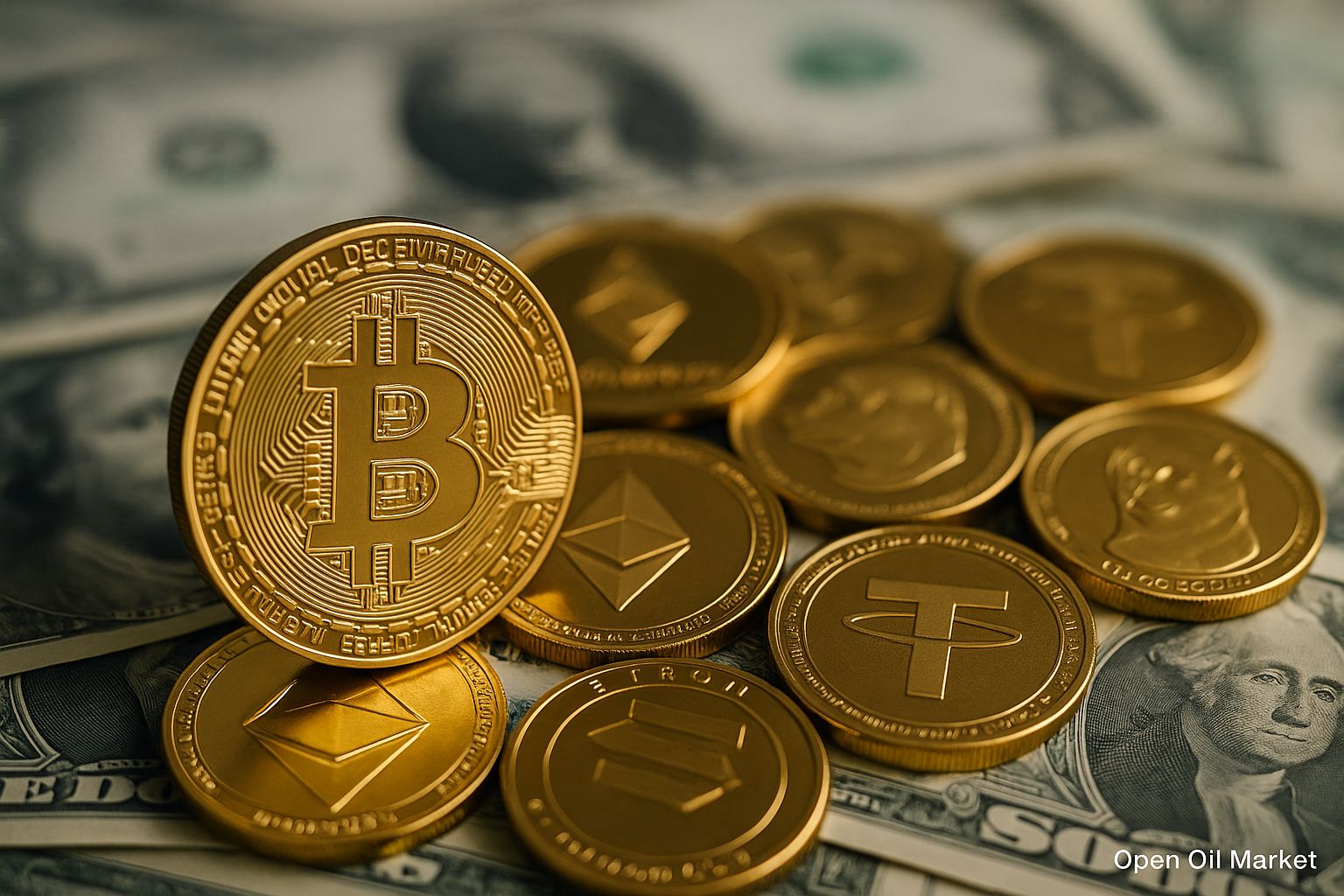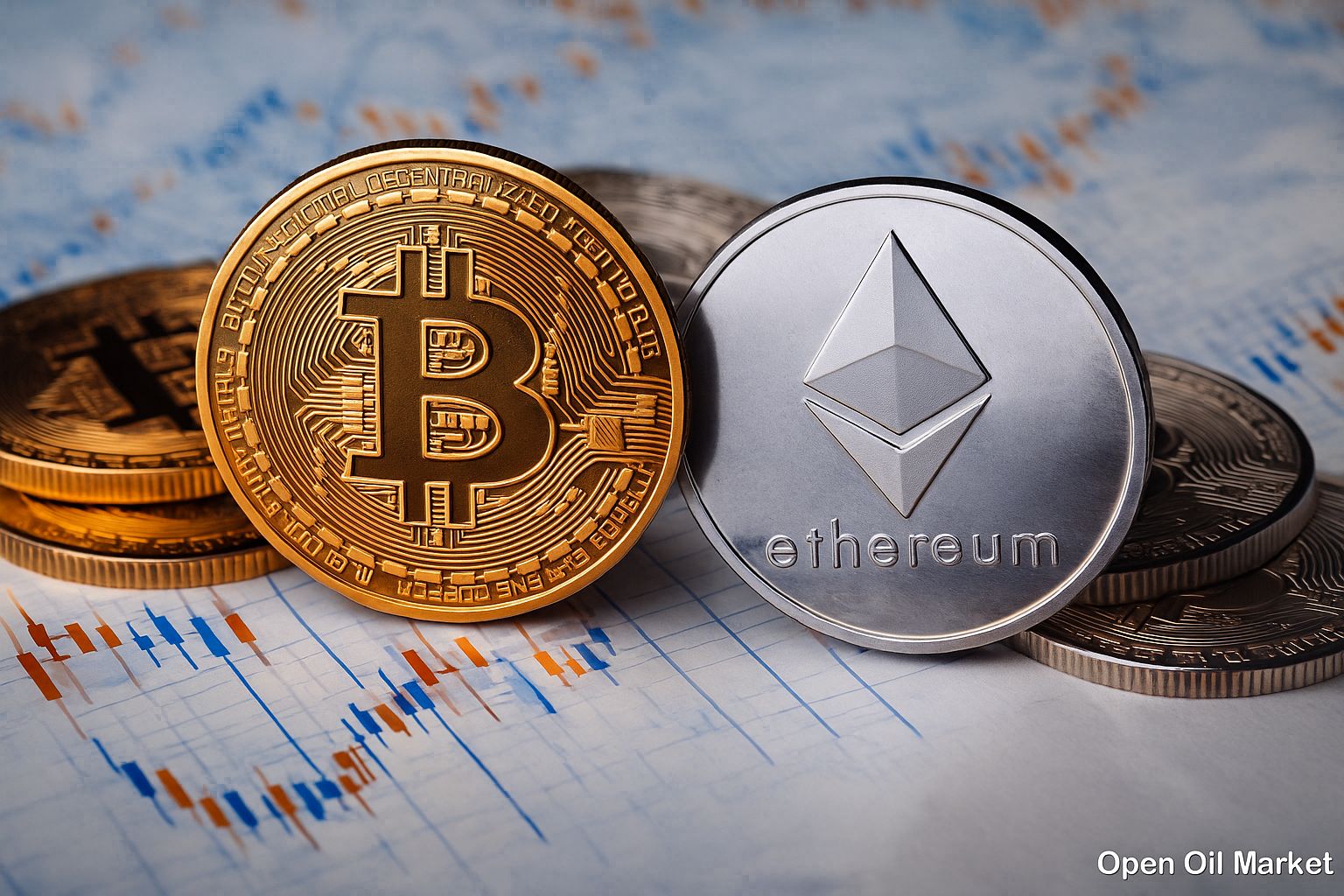
Latest Cryptocurrency News as of 17 October 2025: Bitcoin Stabilises, Ethereum Recovers, Altcoins Rise. Top 10 Coins, Key Market Events, and Analysis for Investors.
By the morning of 17 October 2025, the cryptocurrency market showcases moderate growth following a recent burst of volatility. Bitcoin remains above the $110,000 mark, aiming to test the $120,000 level, thus supporting the recovery of the overall market capitalisation, which is once again above $3 trillion. Following Bitcoin, Ethereum and most leading altcoins are solidifying their gains: the top 10 digital assets are trading in the "green zone". Investors, including institutional participants, are gradually returning to the market amid improving sentiments, ongoing interest in crypto-ETFs, and a favourable regulatory environment.
Market Resumes Growth After Correction
Following a sharp price downturn last week (the so-called "flash crash" of 10-11 October), the cryptocurrency market has stabilised and started to recover. Within just a few days, excessive panic has subsided: the combined market value of crypto assets has recouped a significant portion of its losses. Bitcoin, having briefly dipped below $110,000, has risen again, dragging the rest of the market along. While volatility remains elevated by historical standards, it has noticeably decreased from the peak levels of the previous week. The "Fear and Greed" index, which fell into the fear zone during the crash, has returned closer to the greed mode, reflecting a cautious optimism recovery among participants. The liquidation volumes of margin positions have also decreased to average levels: following record ~$19 billion in forced liquidations during the sell-off, recent days have seen liquidations amounting to just hundreds of millions, indicating some easing of market tensions.
Key Market Indicators:
- Market Capitalisation: ≈ $3.5 trillion
- Bitcoin Dominance: ~60%
- Fear and Greed Index: 60 (Greed)
Bitcoin Targets New Highs
The market leader, Bitcoin (BTC), is consolidating around the $118,000 mark and is close to key resistance in the $120,000 range. The current price is just a few percentage points below its historic peak (around $124,000), recorded at the beginning of October. Despite the recent correction, Bitcoin has gained approximately 45-50% since the beginning of the year, once again outpacing traditional assets (stock indices, gold) and reaffirming its status as "digital gold" for long-term investors. The market capitalisation of BTC now exceeds $2.3 trillion, accounting for more than half of the total cryptocurrency capitalisation. Experts note that Bitcoin's confident recovery after the downturn has boosted market participants' trust: many view the recent drop as a technical breather within the continuing bullish trend.
Additional support for Bitcoin comes from an influx of institutional capital. Launched earlier this month, the first US spot Bitcoin ETF (by BlackRock) attracted over $1.5 billion in investments within a matter of weeks, demonstrating a high appetite among major players. Individual public companies have also seized the opportunity presented by the price decline: for instance, mining firm Marathon Digital Holdings reported acquiring ~400 BTC last week, sending a signal of confidence to the market. On derivative exchanges, stabilisation is underway: open interest in Bitcoin futures holds steady at around $25 billion, while heightened demand for call options indicates expectations for further growth. Collectively, these factors suggest that Bitcoin retains its leadership role and sets the tone for the wider market, continuing to serve as a key compass within the industry.
Ethereum and Leading Altcoins
The second-largest crypto asset, Ethereum (ETH), is also moving upwards confidently. The Ethereum price has once again surpassed the psychologically significant level of $4,000 and is currently hovering around $4,200, approximately 15% below its historic high ($4,890, achieved in November 2021). The upward trend for ETH remains intact: its share of the total market capitalisation holds at around 13%, affirming its status as the largest altcoin. Demand for Ethereum is bolstered by the blockchain's key role in decentralised finance (DeFi) and NFTs. Investors are also encouraged by anticipated technological upgrades aimed at enhancing scalability and reducing fees, which should strengthen Ethereum's attractiveness in the long term.
Among other leading coins, Binance Coin (BNB) stands out — the native token of the largest cryptocurrency exchange, Binance. BNB is currently trading around $1,200 per coin, only slightly below its recent record (~$1,300). Despite facing legal and regulatory challenges, Binance Coin remains within the top five due to its wide range of applications: it is used for fee payments, participating in new token launches, and various DeFi services within the Binance ecosystem. XRP, the token of the Ripple payment platform, continues to hold its position. XRP is trading at around $2.6, having strengthened over the past year on the wave of Ripple's legal victory against the SEC in the US. The legal clarity regarding XRP's status has restored investor confidence: with a market capitalisation of approximately $150 billion, XRP has again found itself among the largest cryptocurrencies, affirming its significance for cross-border payment solutions.
Altcoin Market: Solana, Cardano and Others
The broad altcoin market overall exhibits a synchronous recovery alongside the market leaders. Solana (SOL), one of the fastest-growing blockchain platforms for smart contracts, is holding steady around $200. Just a week ago, SOL experienced a deeper slump than Bitcoin, but with the renewed activity in DeFi applications, its price has rebounded. Interest in SOL is additionally fuelled by rumours of a potential ETF linked to this asset being launched in the US. The successful establishment of such an ETF would make Solana the first protocol after BTC and ETH to have its own fund on the traditional market, which serves as an attractive factor for institutions. Furthermore, the Solana ecosystem continues to grow — new DeFi projects and NFT marketplaces are being launched on the network, reinforcing the fundamental value of SOL.
Another notable altcoin is Cardano (ADA), a smart contract platform developed with a scientific approach. ADA is currently trading at around $0.70, stabilising after sharp fluctuations in the past months. Previously, in August, amid expectations of an ETF launch, the price of Cardano surged close to $1 before undergoing a correction. The Cardano project attracts investors with its long-term potential: the team regularly implements upgrades (e.g., the Hydra scaling protocol), and a large community actively supports the ecosystem. Many ADA holders believe that improvements in network characteristics and the potential launch of financial products based on Cardano could eventually lead the coin to new heights.
Within the top 10 by capitalisation, there are also diverse projects such as Dogecoin and Tron. The meme cryptocurrency Dogecoin (DOGE), initially created as a joke, nonetheless maintains a price of around $0.20 even after a decline of over 20% in early October. Community support and sporadic attention from celebrities allow DOGE to retain its position as one of the largest coins, although its volatility traditionally remains high. The blockchain platform Tron (TRX) is trading at around $0.32; this project is particularly popular in Asia due to its focus on entertainment and Web3. Tron is also known for the significant portion of the USDT stablecoin circulating on its network, while the option to stake TRX attracts users with additional income. The presence of Dogecoin and Tron among market leaders underscores the diversity of the crypto industry: alongside technological platforms, investors also value niche assets focused on communities and specific uses.
Market Leaders: Top 10 Most Popular Cryptocurrencies
- Bitcoin (BTC) — the first and largest cryptocurrency, "digital gold". Price around $118,000; dominates the market and attracts retail as well as institutional investors.
- Ethereum (ETH) — the second-largest crypto asset, the primary platform for smart contracts and DeFi. Price around $4,200; supports hundreds of decentralised applications and is actively being developed to enhance scalability.
- Tether (USDT) — the largest stablecoin, pegged to the US dollar 1:1. Trading at $1.00; serves as one of the main sources of liquidity in the crypto market, facilitating settlements and exchanges between various assets.
- Binance Coin (BNB) — the exchange coin of Binance and the native token of the BNB Chain. Price around $1,200; used for fee payments and access to Binance ecosystem services, remaining one of the most valuable altcoins.
- Ripple (XRP) — the cryptocurrency of the Ripple payment network for global transfers. Price around $2.6; following court successes, the token has regained investor confidence and retains a place among the largest coins, focusing on fast and low-cost transactions.
- USD Coin (USDC) — the second most important stablecoin from Circle. Price $1.00; known for high transparency of reserves and widely used by institutions and DeFi protocols for reliable entry into digital assets.
- Solana (SOL) — a high-speed next-generation blockchain. Price around $200; the Solana ecosystem is recovering after a correction and continues to grow (DeFi, NFT), the SOL coin once again attracts attention from developers and investors.
- Cardano (ADA) — a smart contract platform with a scientifically oriented development approach. Price around $0.70; the project is consistently updated (e.g., the Hydra scaling protocol), boasts a large community, and is considered a promising asset by investors.
- Dogecoin (DOGE) — the most famous meme cryptocurrency, which has evolved beyond a joke. Price around $0.20; supported by enthusiasts and periodically by celebrities, it remains volatile but still ranks among the top ten largest coins.
- Tron (TRX) — a blockchain platform focused on the entertainment industry and Web3. Price around $0.32; known for integrating stablecoins (a significant share of USDT circulates on Tron) and staking opportunities, which help it remain among the leaders.
Institutional Investments: The ETF Effect and Capital Inflows
One of the main drivers of the market in 2025 has been the increasing institutional participation. A landmark event in early October — the launch of a spot Bitcoin ETF by BlackRock — instantly opened access to BTC for numerous large investors through familiar exchange instruments. In less than two weeks, the new fund attracted about $1.5 billion, underscoring the high level of pent-up demand. Moreover, according to CoinShares, last week, total investments in cryptocurrency investment products reached roughly $3.17 billion — one of the highest weekly figures in the history of the industry. The lion's share went to Bitcoin funds (~$2.67 billion), but significant inflows were also recorded in altcoin funds (for instance, Solana attracted ~$93 million, XRP — ~$62 million over the week). These figures indicate that institutional investors are interested not only in BTC but also in other digital assets.
Participants in the traditional financial market continue to integrate with the crypto industry more actively. Several large managing companies, including Fidelity and Invesco, are awaiting decisions on their applications to launch their Bitcoin ETFs and are submitting new applications related to Ethereum and other top assets. In particular, the SEC is currently reviewing applications for spot ETFs linked to Ethereum, as well as separate initiatives to launch funds based on Solana and Cardano — which only recently seemed unthinkable. Aside from financial instruments, banks and payment corporations are also exploring cryptocurrencies: Visa and Mastercard are expanding services related to stablecoins and crypto payments, while a number of international banks are launching services for the custody and trading of digital assets for clients. The expansion of the product line (ETFs, trusts, custody services) and such involvement from Wall Street in the crypto industry are boosting market liquidity and bringing it closer to maturity.
A sign of the convergence between cryptocurrencies and traditional finances has been the intention of some crypto companies to go public. Recently, plans surfaced for the Gemini exchange to conduct an IPO in 2026. If these plans materialise, it will mark the first public offering of a major crypto platform since the Coinbase listing in 2021. The presence of crypto company shares on traditional exchanges, along with the growth in institutional investment products, strengthens trust in the industry from conservative investors. Overall, the influx of "smart money" continues to grow, solidifying cryptocurrencies’ status as a legitimate asset class.
Regulation and Security: New Rules and Growing Trust
The global regulatory environment for cryptocurrencies is gradually clarifying, facilitating long-term trust in the market. In the European Union, the comprehensive MiCA regulation is coming into force, aimed at establishing uniform rules for the crypto industry and protecting investors. In the UK, authorities are working on creating their own regulatory framework for digital assets, striving to make London’s financial centre attractive for the crypto business. In several other jurisdictions (e.g., UAE, Hong Kong), crypto-friendly licensing regimes are being implemented: these regions aim to attract innovative companies and capital by offering clear operational rules. While increased oversight imposes additional requirements on the industry — such as adherence to AML/KYC procedures, reporting, and licensing exchanges — it ultimately enhances market transparency and protects participants. Many analysts agree that clearer "rules of the game" are likely to attract even more institutional investors who were previously wary of regulatory uncertainty.
Regulators are also paying increased attention to security and combating illegal operations with cryptocurrencies. A recent precedent in the US is telling: the Department of Justice initiated the largest cryptocurrency asset seizure in history, confiscating over 127,000 BTC (approximately $15 billion) in a case of international fraud. This case demonstrates the determination of authorities to combat crime in the digital currency sphere. Simultaneously, measures to prevent cyberattacks and hacking are being actively discussed worldwide: exchanges are enhancing security systems, and regulators are demanding strict measures to safeguard customer funds. Although these steps introduce additional checks and balances, they ultimately create a more robust market infrastructure.
The industry itself is also learning from recent events and taking steps to bolster its reputation. Major players are ready to share responsibility for the stability of the ecosystem. For instance, the Binance exchange announced the establishment of a special fund worth $400 million to compensate users affected by the sharp price drop in October. Of this amount, $300 million will be directed towards payments to retail traders (in proportion to their losses), while $100 million will be allocated for concessional lending to institutional clients to support their liquidity. This voluntary step by Binance seeks to restore trust in the industry after a stressful event. Analysts consider such initiatives to be signs of market maturation: large companies are increasingly taking preemptive actions to protect users and prevent systemic risks. In combination, the tightening of regulatory oversight and responsible actions by businesses are making the crypto ecosystem more resilient and attractive to new participants.
Market Outlook: Moderate Optimism
Despite the turmoil experienced, the long-term prospects for the cryptocurrency market remain positive. The majority of analysts note that fundamental factors — the limited supply of Bitcoin, increasing institutional engagement, and the technological advancement of blockchain platforms — continue to support the bullish trend. Large financial organisations are revising their forecasts upwards. For example, Standard Chartered recently raised its Bitcoin target for the end of 2025 to $200,000 (previously expected at $120,000 to $150,000), and for Ethereum — to ~$7,500. Bank analysts cite the accelerating adoption of crypto assets by institutional investors and a reduction in BTC supply due to the 2024 halving as the key reasons for this optimism. A number of independent experts also believe that the current growth cycle has not yet peaked: forecasts suggest possible Bitcoin prices rising to $180,000–200,000 and Ethereum to $8,000–10,000 over the next year, provided there are no severe macroeconomic shocks.
However, the path to new records may be uneven. Following the powerful rally in mid-2025, the market may well enter a phase of consolidation. In the coming weeks, sideways price movements and short-term corrections are not ruled out as some investors take profits and new participants accumulate positions on dips. Temporary pullbacks could also occur due to external factors: for instance, a tightening of rhetoric from the Fed or escalating geopolitical conflicts could trigger a wave of risk asset sell-offs. Some analysts caution that if a negative scenario unfolds, Bitcoin may retest support levels around $100,000 before continuing its upward journey. However, many view such pullbacks as a healthy occurrence for a nascent market.
Experts advise investors to maintain a balanced approach under these conditions. Even with a positive long-term outlook, it is crucial to manage risks: avoid excessive leverage, diversify portfolios, and be prepared for high volatility. Experience shows that periods of euphoria are often followed by cooling phases which, however, set the stage for another growth surge. The history of previous cryptocurrency market cycles confirms that every significant correction in a bullish market was eventually followed by an even more powerful rise. If current macroeconomic and regulatory trends persist, the crypto market has every chance to continue expanding in the foreseeable future. Many participants anticipate new historical highs for key digital assets in the latter half of this year and into 2026. Thus, the overall trend remains upward, with short-term fluctuations merely a natural part of the movement towards new peaks.




